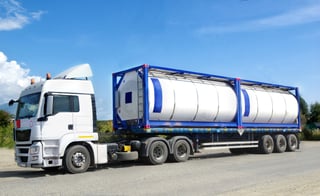In the 1990s, ISO containers were fairly rare, outside of coastal areas. With the rise of global corporations and international shipping, they have become a common solution for industrial transportation. Once used primarily to transport chemicals overseas to Singapore, China and other destinations, fleets of isotainers and seatainers now supply many facilities within the United States.

The growing popularity of ISO containers also presents new industrial safety challenges for companies and their workers. That means it’s more important than ever to provide safe access for loading and unloading this equipment.
In blog two of this three-part series, learn more about a critical workplace safety concern associated with handling isotainers:
Undefined Loading And Unloading Procedures
On the most basic level, loading and unloading ISO containers sounds straightforward. Specially made forklifts move ISO containers to the loading area, where large cranes move them and stack them onto ships.
During unloading, these cranes trolley out over the ship and pick up containers one at a time. From there, longshoremen use forklifts to inventory and tag the containers, and trucks come in with isotainer chassis to transport the containers to their destination.
But the process grows more complicated once the ISO containers reach the customer or the end point.
Containers typically have hatches where workers must attach a hose, loading arm or other device in order to remove the product. In many facilities, there’s no clear procedure for unloading (and possibly reloading) the products inside these various types of ISO containers. Open-top containers, often used to carry materials like coal or grain, should be loaded from the top or the end, while dry freight containers are front-loaded.
Without specific procedures, workers could risk serious injury or death when unloading the product.
Examples Of Improper Loading And Unloading
A tank container is a cylinder mounted in a rectangular steel frame, and looks much like a tank car. It’s typically used to transport liquid chemicals. Without a clear procedure, workers often assume they should unload it the same way as they would a tank truck, which isn’t necessarily safe. When unloading liquid from a tank container, workers may attach a hose to a valve on the bottom of the tank.
Depending on the operation, workers in hazmat suits may also be standing on top of the container, which carries risk of falling off the side or through a hole in the grating. One company, for example, realized that when loading a certain type of container, the safety grating on their platform didn’t cover the entire work area. While the handrails and other safety measures on the platform provided some protection from falling over the side of the container, they had a big hole in the platform, creating a serious safety hazard. When unloading an isotainer, a worker could slip between the tank and the container’s frame and fall to the ground.
If your company does not have the necessary safety equipment and procedures in place to facilitate safe isotainer loading and unloading, it’s time to reevaluate your work site. By providing your employees with a safe working environment, you reduce the risk of serious and sometimes fatal accidents.
In part three of this blog series, we explore how you are able to improve your industrial safety measures with safety solutions that minimize the dangers of loading and unloading ISO containers.
Are you ready to elevate your safety procedures by promoting a company-wide culture of safety? Learn why mere OSHA compliance is insufficient for your facility.



